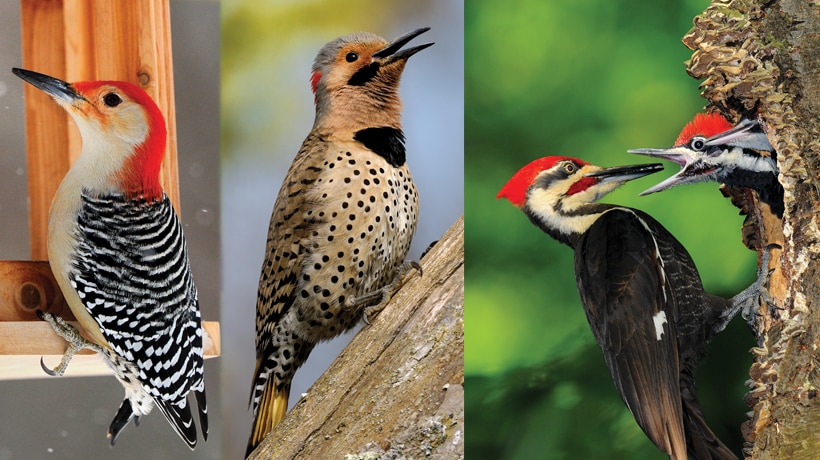Coming Across Woodpeckers in Florida: Variety Variety and Recognition
Coming Across Woodpeckers in Florida: Variety Variety and Recognition
Blog Article
Revealing the Tricks of Woodpeckers: Habits, Habitat, and A Lot More
Woodpeckers, with their unique behaviors and specialized adjustments, have actually long interested researchers and nature enthusiasts alike. By revealing the mysteries surrounding woodpeckers' behavior and environment choices, a deeper understanding of these avian marvels emerges, supplying a glimpse into their remarkable world.
Woodpecker Habits Insights
In checking out woodpecker actions, a remarkable display screen of specialized skills and adaptations emerges, shedding light on their exceptional ecological specific niche. Woodpeckers, recognized for their distinctive drumming on trees, possess a range of behavioral qualities that add to their survival and success in their setting.
In addition, woodpeckers display a distinct feeding actions identified by their capacity to remove pests from tree bark utilizing their specialized beaks. Their long, barbed tongues help in capturing prey, while their strong neck muscles offer security and precision throughout pecking movements. This feeding method enables woodpeckers to accessibility hidden insect larvae and extract them with exceptional effectiveness.
Environment Preferences and Selection
What factors affect the environment preferences and choice of woodpeckers? Woodpeckers are very adaptable birds understood to populate various settings worldwide. They do exhibit choices for specific environment features. One critical aspect affecting woodpecker habitat choice is the schedule of ideal nesting sites. Woodpeckers typically choose forests with a mix of mature trees that provide enough opportunities for cavity excavation. These tooth cavities serve as critical nesting and roosting sites for woodpeckers and are necessary for their reproducing success.
Furthermore, woodpeckers show a preference for habitats with a bountiful supply of food resources. They are mostly insectivorous, feeding on beetles, ants, larvae, and other bugs discovered in decaying timber or tree bark. Woodpeckers often tend to prefer wooded areas with a diverse insect population to satisfy their dietary requirements.
Additionally, the visibility of dead or decaying trees is an additional key aspect in woodpecker habitat option. These trees not only offer food sources but likewise use suitable substrate for dental caries excavation. Dead trees are important for the maintenance of healthy and balanced woodpecker populations, as they play a crucial duty in the woodpeckers' life process and community dynamics.
Feeding Routines and Diet Regimen Make-up
Woodpeckers demonstrate a specialized feeding actions focused on foraging for insects within numerous environments. Their diet regimen largely contains bugs such as beetles, ants, caterpillars, and spiders, which they situate by touching try these out on tree bark and listening for the audio of movement inside. Woodpeckers utilize their solid beaks to drill into the timber and their long, barbed tongues to remove victim from crevices. Along with insects, woodpeckers likewise eat tree sap, fruits, nuts, and seeds, including variety to their diet depending upon the season and availability of food resources.
The foraging strategies of woodpeckers are well-adapted to their arboreal way of living (Woodpeckers in Florida). Their ability to dig deep into wood not just offers them with food yet additionally aids in creating nesting cavities and establishing territories. Woodpeckers play a vital duty in preserving the wellness of woodlands by regulating insect populaces and helping in the decay of timber. Understanding their feeding habits and diet regimen structure is important for preservation efforts intended at maintaining these one-of-a-kind and important birds.
Drumming Seems and Interaction
Utilizing rapid drumming noises on numerous surface areas, woodpeckers use a distinct form of interaction to signal territory boundaries and attract mates. This drumming behavior is not only a way of interaction but additionally serves as a means for woodpeckers to develop their visibility within a certain area. The intensity, rate, and pattern of the drumming can communicate vital details to other woodpeckers in the location.
Woodpeckers use drumming noises to reveal their visibility in a region and to warn off potential trespassers. The loud and repetitive nature of the drumming works as a clear signal to various other woodpeckers that the area is currently declared. This helps in reducing conflicts and minimizing physical confrontations in between people.

Survival Adaptations and Specialized Anatomy
:max_bytes(150000):strip_icc()/GettyImages-1094628502-a831e9c1be004c05b057f488ff819127.jpg)
Final Thought
To conclude, woodpeckers display one-of-a-kind habits, such as drumming noises for interaction, and have specialized anatomy for survival in their picked environments. Their feeding go to this website behaviors and diet make-up even more show their versatility to different settings. By recognizing these aspects of woodpeckers, researchers and guardians can much better protect and protect these fascinating birds and their ecological communities.
Report this page